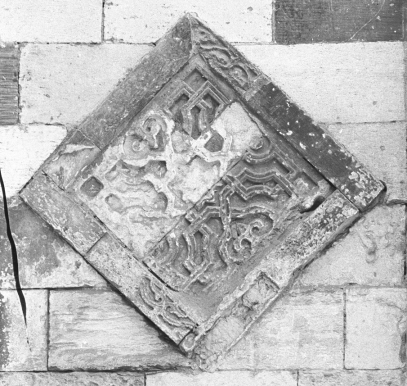
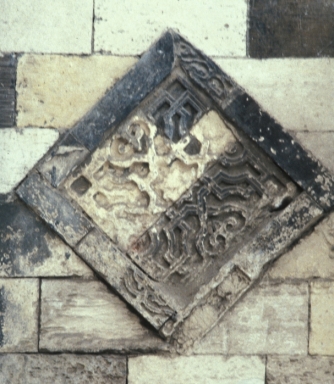
Figure 52. Northwestern rotated square.
Table of Contents
For want of another short term I call squares set on one point “rotated squares”.
[Links: Southeastern rotated square, Creswell Archive, negative EA.CA.1356 (cf. Creswell, Muslim Architecture of Egypt, v. 1, fig. 25); main entrance, northeast side, central section, Bulletin of the Comité de Conservation des Monuments de la Art Arabe for 1907, pl. 2.]
There are two rotated squares on the northeast side of the main entrance, first published, I believe, by the Comité de Conservation des Monuments de la Art Arabe in 1907 or 1908 from photographs by Flury in 1902.107 Flury remarked (in 1912) that Max Herz had done restoration on the northwestern niche in the last ten years. The photograph showing the rotated squares that was published by the Comité, an online image of which is linked to above, already shows some restoration; Creswell Archive negative EA.CA.3102 shows a slightly larger area but after what I take to be Herz's restoration. It may be the source of his pl. 17, but (as scanned) is in higher contrast, showing the restored (lighter) stone more clearly.
In 1902 the southeastern square lacked its top corner and some of the bottom corner. By the time of Creswell's photographs it had lost even more of the bottom part; his drawing (fig. 25) is a reasonable attempt at restoration. In 1902 the northwestern square lacked its lower right half and some of its top corner; these were the portions that were light-colored when I took my photographs (below); Creswell attempted no restoration of this square.
[Links: The extent of restoration appears in Creswell Archive, negative EA.CA.3102, EA.CA.1355, and EA.CA.1356.]
The top corners of these rotated squares lie within the second course below the lower cornice of the frieze zone. I deal with their borders very briefly in Chapter Seven, Foliate Bands and Borders. None of the fields has foliage. Creswell described their compositions:108
The left [southeastern square] has as main motif an eight-pointed star formed of two crossed squares, the alternate points being connected by loops with four circles which just touch the circumscribed square. These four circles are also connected by loops with a smaller central circle, outside which is a four-lobed motif. The grooved bands which form all these motifs pass under and over each other alternately. The decoration of the outer border is similar to that on the soffit of the left hood [niche head]. The right-hand [northwestern] panel is filled with a design which also develops from a central eight-pointed star.
The southeastern niche head has no real soffit, and its underside where it oversails the corners of the shallow niche is undecorated; Creswell had in mind what I call the upper cornice of the frieze zone.
[Link: Northwestern rotated square, Creswell Archive, negative EA.CA.1355.]
 
Figure 52. Northwestern rotated square. |
Even the southeastern square is so heavily restored that its over- and underlappings cannot be determined reliably from photographs or Creswell's drawing. That said, both squares have symmetry of reflection along the central vertical and horizontal axes, as well as the two diagonal axes, if interlacing is disregarded.
It is obvious that, as with the niche heads above, there is a deliberate variety in the ornament, the southeast square's design being curvilinear and the northwestern square's angular; in the niche heads it is the reverse. This is what Robert Hamilton termed a “chiasmic” arrangement; see my Constructs of Symmetry in Islamic Art, Appendix A, Western Symmetries Outside the West, n. 15. The borders also differ, geometric for the curvilinear field, foliate for the angular field.
In the western minaret there are three rotated squares 1.30 by 1.26 m. in the sixth register of both the southwest and northwest sides of the square section; the northeast side is inaccessible and most of the southeast side is part of the northwest exterior wall of the mosque.109
Creswell wrote of the squares of the southwest side that “the central one has suffered so badly that little more can be distinguished than the remains of four circles, one in each corner, recalling a composition decorating one of the lozenges on the north-east side of the main entrance (Fig. 25).”110 I have found no photograph of the central square; it is sketched on the elevation (fig. 40).
I discuss the foliate borders of these two rotated squares in “Borders of S-Shaped Foliate Elements”.
[Link: Sixth register, southwest side, northwestern rotated square, Creswell Archive, negative EA.CA.118 (Creswell, Muslim Architecture of Egypt, v. 1, pl. 28, a; see also fig. 39, left).]
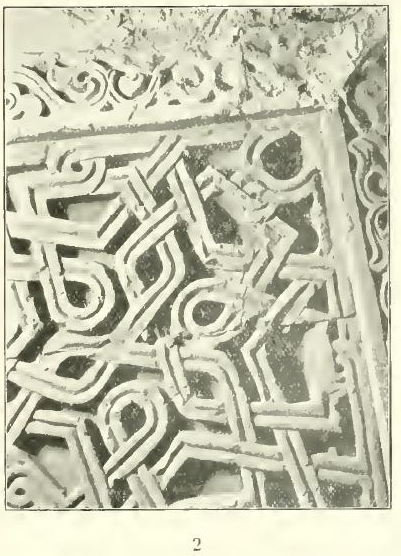 Figure 53. Sixth register, southwest side, northwestern rotated square; Flury, Ornamente, pl. 30, 2. |
The northwestern square is composed of grooved bands that appear to overlap and join to form a border within a possibly wider plain border; these details are not correct in Creswell's drawing (Muslim Architecture of Egypt, v. 1, fig. 39, left), which is also inaccurate in other ways, such as the relative width of the elements of the design. Some of the places where the bands join the borders are T-junctions, so every part of the design is connected to the rest topologically.
This square has symmetry of reflection only along the horizontal center axis and only while disregarding over- and underlapping. In the center, three sections of band overcross and undercross each other, proceeding to over- and undercross each other again; the design is then adjusted to its square frame by developing differently on left and right, and differently in the top and bottom corners than in the left and right corners. A six-pointed star can be picked out in this design, with a point at left and right.
[Link: Sixth register, southwest side, southeastern rotated square, Creswell Archive, negative EA.CA.1642 (Creswell, Muslim Architecture of Egypt, v. 1, pl. 28, b; see also fig. 39, right).]
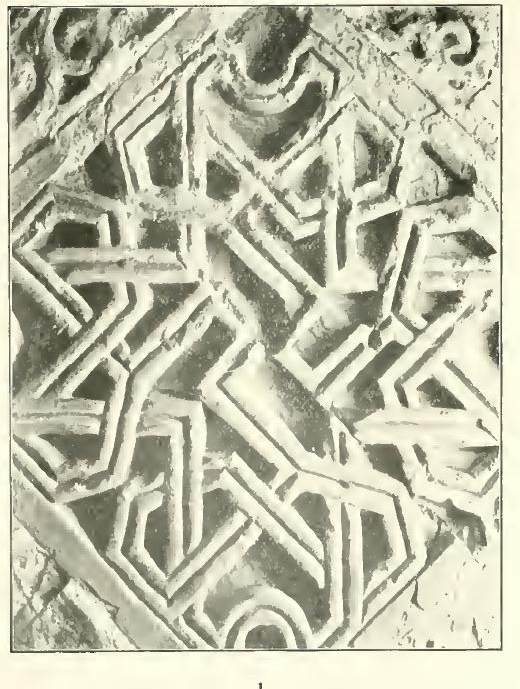 Figure 54. Sixth register, southwest side, southeastern rotated square; Flury, Ornamente, pl. 30, 1. | 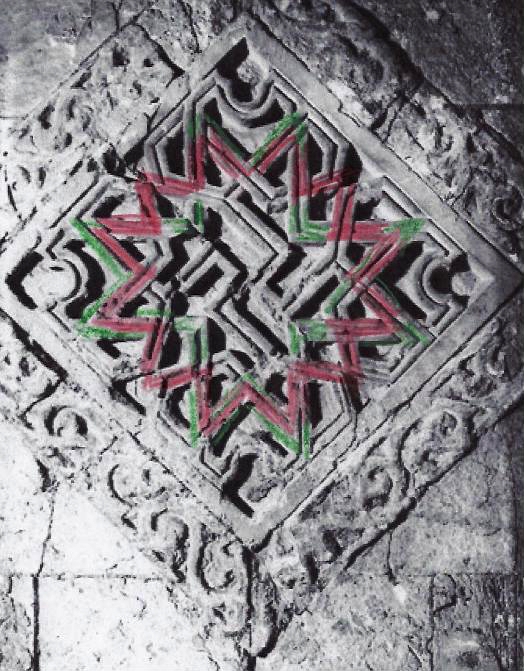 Figure 55. Sixth register, southwest side, southeastern rotated square; geometric figures. |
The southeastern square on the same side has an inner plain border, which the grooved band segments forming the design do not overlap (neither do they unite to form a continuous outer band). Creswell's drawing is clearly inaccurate in details (as in the corners and its orientation), and I disregard it. Again, the bands join in T-juntions, so every part of the design is connected to the rest.
At the center two bands, each shaped like a squared U, touch at their corners but do not join. They continue to over- and underlap and join, eventually leaving small curved voids in the corners, in contrast to the pointed loops of the northwestern square. Star-shaped polygons with both eight and ten points can be discerned, although neither is entirely regular. The only symmetry here is of rotation, 180° around the center.
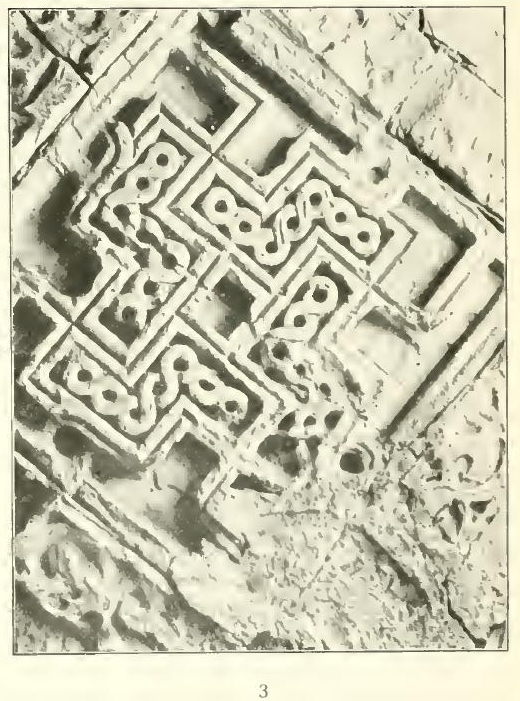 Figure 56. Sixth register, northwest side, rotated square; Flury, Ornamente, pl. 30, 3 (cf. Creswell, Muslim Architecture of Egypt, v. 1, pl. 29, d). |
Creswell illustrated one rotated square on the northwest side, in the same register as those on the southwest side, but does not mention any of the squares on this side, saying only that the northwest side is like the southwest side. The outer foliate border of this square is too deteriorated to classify. In the field grooved bands meet in T- and X-junctions and form loops near the centers of the sides, overlapping or running into a grooved border, and also butting into it (left corner).111 The bands develop from a central square, making swastikas in each of the quadrants, the inner angled compartments so formed being filled with cable motifs bound off at the ends. Here there is symmetry of rotation, multiples of 90° around the center. The design is more like a Late Antique floor mosaic than any of the others.
There should be two more squares on the northwest side. Flury illustrated two that Creswell did not.
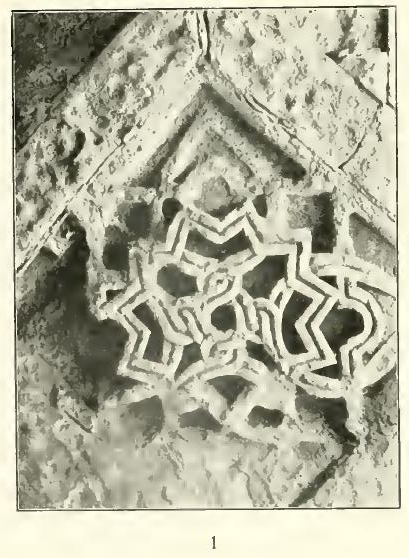 Figure 57. Sixth register, northwest side(?), rotated square; Flury, Ornamente, pl. 31, 1. | 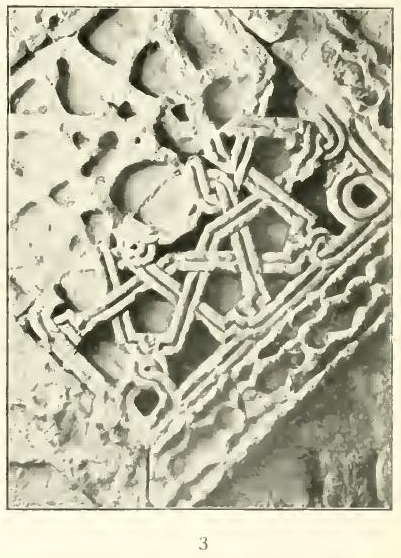 Figure 58. Sixth register, northwest side(?), another rotated square; Flury, Ornamente, pl. 31, 3. |
One of these, in a border the design of which was undistinguishable in Flury's day, has a circular design in one corner, but overall, and in part because of considerable loss, it matches Creswell's description of the central square of the southwest side. It has a central quadripartite design of intertwined curvilinear band sections, then develops differently on left and right than on top and bottom (inferring the left and the bottom from the top and the right), accomodating an eleven-pointed star more or less set on top of the rest of the design.
The other of these squares has a geometric border, discussed in Chapter Eight, Geometric Bands and Borders. It develops from a circular interlace in the center, in which the crossover points are offset from the vertical and horizontal. From these intertwining points the band segments extend at two different sets of angles, developing into a quasidecagram (lacking some internal construction lines) with truncated points, the bands crossing over and under each other as they join the grooved border. The corners have pointed ovals instead of curved voids.
[Links: Northeast side, central section, Bulletin of the Comité de Conservation des Monuments de la Art Arabe for 1907, pl. 2; Northeast side, southwestern niche head, Bulletin of the Comité de Conservation des Monuments de la Art Arabe for 1907, pl. 3.]
The northeast side of the main entrance preserves the only two niche heads from a design that featured perhaps four more (two on the southwest side and one each on either side of the portal bay). The photographs published by the Comité de Conservation (discussed in “Rotated Squares in the Main Entrance” and linked to above), apparently taken by Flury in 1902, show the condition of the niche heads before restoration, although perhaps after some consolidation work. Flury's published photograph, below, is less clear but of the same state. A comparison of Flury's photograph and mine (from 1983) shows that the upper right quadrant of the southwestern niche head has been reconstructed. The Comité's pl. 3 shows a chunk missing from the northwestern niche head; the missing portion later extended to the middle of the niche head, and had not been restored, or not much, in 1983.
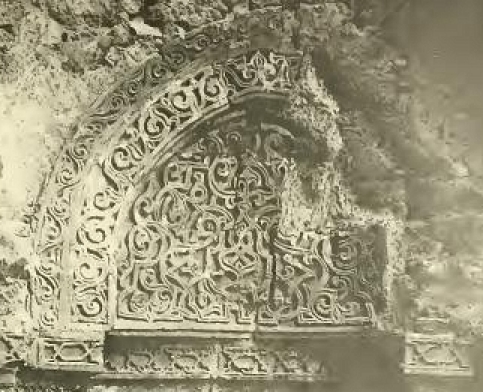 Figure 59. Southeastern niche head; Flury, Ornamente, pl. 19, detail. |
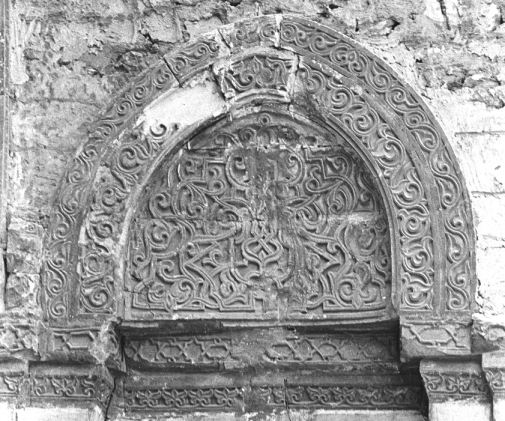 Figure 60. Southeastern niche head. |
I do not believe that a detailed description of the design would be useful, as it is shaped to fit its space in so many ways. Its salient characteristics are that it is mainly formed of grooved stems, with few leaves; it has symmetry of reflection with respect to the vertical center axis if one disregards interlacing (which seems inconsistent); it contains both curves and angles; and it does not overlap or intersect with its plain border, although the stems run along portions of the edge of the design as if forming a discontinuous border.
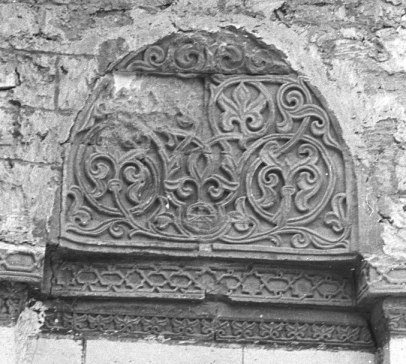 Figure 61. Northwestern niche head. |
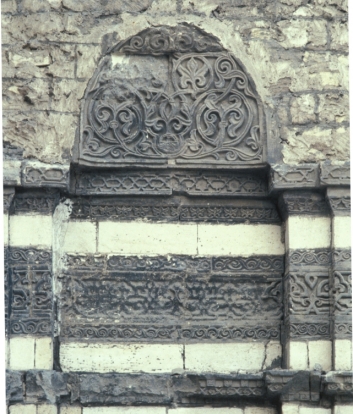 Figure 62. Northwestern niche head. |
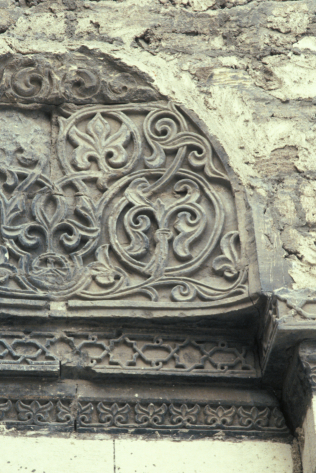 Figure 63. Northwestern niche head, detail. |
For the northwestern niche head, again, no detailed description is useful, but in this case because the design is basically a rinceau developed along a central vertical axis (about which it has symmetry of reflection if one disregards interlacing, again inconsistent, along that axis). There is an obscure round device at center bottom. Around and above that device the foliage is composed of grooved stems with fewer but more developed leaves than in the southeastern niche head. The loops and leaves diminish from bottom to top as a means of fitting the design to its space, although the design in the top course (of three) seems oddly ill-connected to the design in the course below. There are no straight lines. There are also two rings around single stems (in the bottom course), which suggests a loss of understanding as to the function of this design device (rings around stems formerly grouped two stems together). The border is plain.
The angularity of the one and the nonangularity of the other niche head are in sharp and surely deliberate contrast, and, as I remarked in “Rotated Squares”, swap left and right with the rotated squares below, in a chiasmic arrangement. The designs of both niche heads are shaped to fit their spaces, they are formed of grooved stems that do not run into a border, and they have symmetry of reflection with respect to the vertical center axis if one disregards (inconsistent) interlacing.
There are circular devices on both minarets that Creswell appropriately called medallions.
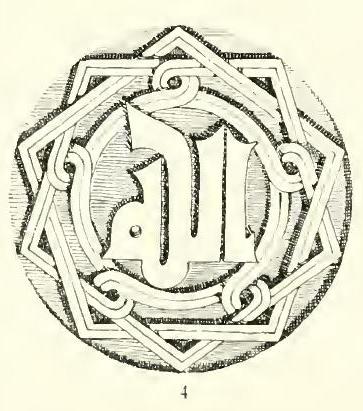 Figure 64. Northern minaret, socle, medallion on northeast side; Flury, Ornamente, pl. 25, 4. |
On the northern minaret a medallion is centered in each of the three exposed sides of the second register of the socle: southeast, northwest, and northeast. Of these Creswell wrote:112
A medallion, 42 cm. in diameter, is set in the centre of each side, in the smooth space 55 cm. broad, left between [two carved moldings]. The north-eastern one consists of a ten-pointed star composed of two interlacing pentagons, the sides of one being linked by small loops to a central circle containing the word Allāh. The medallion on the north-west side has almost gone, but the south-western one is well preserved. It is composed of a combination of five circles and a five-pointed star (pentagram). It belongs to the same school of design as the square in the left panel of the monumental entrance.
The medallion on the southwest side Creswell illustrated with an original drawing (fig. 35); that on the northeast side with a drawing (fig. 34) taken from Flury (above); and that on the northwest side not at all. The medallion on the northeast side contains a pentagon standing on one angle interlaced with another that is composed of what are topologically five interlinked loops, surrounding the word Allāh in the center. The medallion on the southwest side contains a regularly interlaced pentagram that is also interlaced with a pentagon the angles of which have been elaborated into circles and the sides into cusped projections, the center filled with a five-lobed rosette.
[Link: Northern minaret, cylindrical section, second register, medallion on northeast side, Creswell Archive, negative EA.CA.126 (Creswell, Muslim Architecture of Egypt, v. 1, pl. 24, d).]
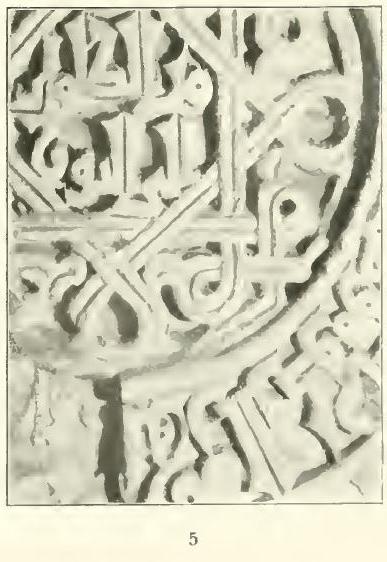 Figure 65. Northern minaret, second register, medallion on northeast side; Flury, Ornamente, pl. 25, 5. |
The second register of the cylindrical section of the northern minaret probably had three medallions, centered on the sides of the square section. Creswell wrote:113
The second band is decorated towards the north-east and north-west with fine medallions. The former consists of a central, slightly sunk part 75 cm. in diameter containing an eight-pointed star formed by two crossed squares, the corners of which are linked to the circumference by loops; in the centre are two lines of plain Kufic. The whole is set in an outer band of Kufic, the total diameter being 1.22 m. The central part of the north-western one has suffered badly. A similar medallion doubtless faced south-west, but this part is hidden by the rubble filling, which still remains at this point.
The northeast medallion is actually more complex. The circular Kūfic inscription is bordered by flat bands, within which the design is composed of grooved bands. A square oriented with points at top and bottom is formed by a continuous band that loops at the corners, over- and undercrossing regularly and overlapping segments of a discontinuous grooved inner border. A second square, standing on one side and interlacing with the first regularly, is formed by parts of two figures, of which only the one on the right is visible in Creswell's photograph. On the right side of the field the figure is part of the discontinuous border; at top and bottom of this arc the band turns inward horizontally, forming loops at top and bottom that are embellished with small stub leaves, the only foliage. The loops are connected by a vertical segment of the figure, which forms the right side of the square standing on one side. Finally, another figure forms part of the discontinuous border at top and bottom, nearly connected on the right (and I assume on the left) by vertical segments parallel to and outside the right side of the square standing on one side. Instead of actually connecting, these segments loop, grow stubs leaves next to the outer corner of the square standing on one point, and run horizontally left to form the top and bottom of the square standing on one side, which is, thus, formed by parts of three figures. In the octagon bounded by the two squares is a short Kūfic inscription.114
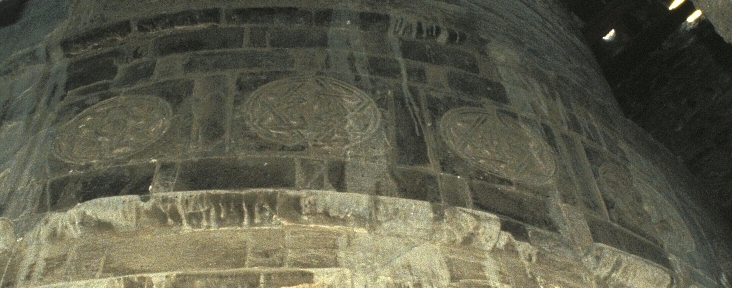 Figure 66. Northern minaret, eighth register, medallions. |
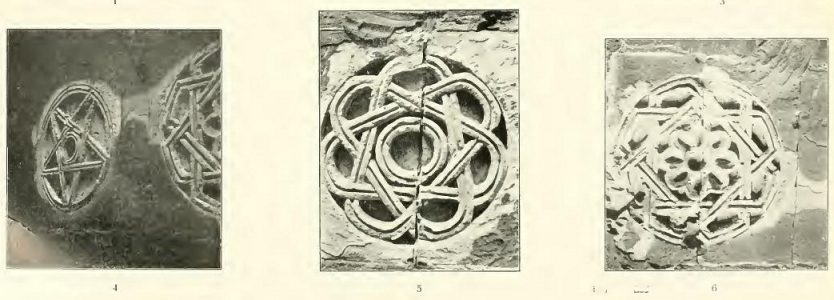 Figure 67. Northern minaret, eighth register, medallions; Flury, Ornamente, pl. 29, 4–6 (cf. Creswell, Muslim Architecture of Egypt, v. 1, fig. 36). |
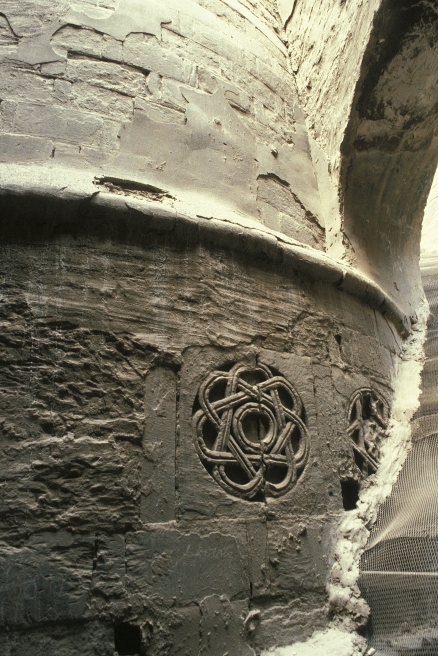 Figure 68. Northern minaret, eighth register, medallions. |
In the eighth register of the cylindrical section of the northern minaret is a frieze of medallions. Creswell wrote:115
The eighth band consists of a row of medallions about 53 cm. in diameter, spaced 23 cm. apart. One contains an inverted pentagram, another an eight-pointed star formed, as usual, by two crossed squares, another a seven-lobed rosette, formed by a continuous interlacing band like the six-lobed rosettes on the Bāb al-Naṣr. The medallion which faces south-east has been converted into a bull's-eye window.
Creswell published Flury's photographs, above, but differently ordered (pl. 26, a–c). They are only a sample of the entire set, which must number over two dozen, to judge from Creswell's elevation of the minaret (fig. 36). The leftmost of the medallions in my photograph above (Figure 66, a detail of Figure 23) is above the window facing west.
I omit detailed descriptions of the individual medallions.
The salient characteristics of the medallions are:
There is a variety of radial symmetries, as Creswell noted. Figures with five, six, seven, eight, and ten axes are used.116
However, there does not seem to be any significant sequence of radial symmetries: there is no apparent progression, and hexagrams appear side by side in the same orientation (in Figure 66) or alternate orientations (in Creswell's drawing).
The medallions have no consistent borders. One involves a pentagram that overlaps or perhaps is combined with a circular border (Figure 67, 4), another a construction apparently of two squares but actually of a more complicated set of interlinking figures, forming partial segments of a circular border (Figure 67, 6), like the medallion of the second register of the north minaret discussed above (“The Medallions of the Second Register of the Northern Minaret”).
The variety of the medallions may be compared to the round geometric devices in the famous squares of Leon Battista Alberti's attic story in the facade of the church of S. Maria Novella in Florence (designed 1439–42, constructed after 1458), where there is also a variety radial symmetries; Alberti's round designs have been seen as symbolizing the Sun.117 Whatever symbolism the northern minaret medallions may have, the designers of both monuments felt it desirable not to repeat the same design or create a rhythm of various designs, but to employ what I call variation in coördinate detail.
In the base of the first octagonal story of the western minaret there is a curious room. Creswell describes it as
a sort of little oratory on the south-east side, which opens on to the staircase by a keel-arch and on to the exterior by a pointed arch set in a projecting rectangular frame with remains of a cresting resembling the design on the fourth octagonal storey. The lower part of this frame is flush with the bottom edge of the blind cresting at the top of the square storey. The little oratory is 1.25 m. deep, 1.10 m. wide, and 2.54 m. high. To right and left are little arched recesses like miḥrābs, 62 cm. wide and 24 cm. deep, with recesses for nook-shafts, and in each spandrel is a pentagram. The flat stone ceiling, which is finely decorated, rests on a splay-faced cornice.
This little oratory is constructed so as to form a salient of 47 cm. on the south-east face of the first octagonal storey. In other words, the octagon on this [southeast] side is set back 47 cm. from the face of the cresting; on the opposite [northwest] side, however, the face of this storey is only set back 12.5 cm. The result is that the true axis of the octagonal storeys is displaced 17 cm. to the north-west of the axis of the square part, but as the sides of the octagon are not all equal, the western being longer than the southern, the result is that the centre of the western side and its windows are kept very nearly on the axis of the lower part, as shown [in the elevation of the minaret, fig. 40].118
This description would be clearer had Creswell illustrated it with a few more drawings. The reconstructed bird's-eye view (fig. 44) looks east and thus shows the northwest, west, and southwest sides of the octagonal section. The elevation of the minaret (fig. 40), shows the southwest side (looking northeast), with the shift from square to octagonal plan indicated in a most unsatisfactory manner; the south and west sides of the octagonal section appear as well as the southwest side.
The southeast side is that facing the qiblah and is invisible in both birds-eye reconstruction and elevation. The setbacks of the southeast and northwest sides, however, are seen in the elevation, as is the projection on the southeast side (on the right). The birds-eye reconstruction shows two of the four round buttresses in this register, as does the elevation (almost invisibly, through thin vertical lines and changes in the density of the foliate border at the top of the register).
Creswell did not describe the entrance from the staircase very well. Scaling from the elevation, the first octagonal register is almost seven meters wide without the projection formed by the niched room. Scaling from the plan, the room is about 1.7 m. from the outer face of the entrance to the outer face of the arch on the other side, which “opens … on to the exterior”. Nowhere did Creswell give the dimensions of the staircase or its “circular [in plan] newel”119 explicitly, but, scaling from the plan of the mosque (fig. 32), the staircase is a little over four meters in diameter (in the square section of the minaret). I conclude that the entrance from the staircase is direct. Its staircase side is also unillustrated. Creswell's fig. 41, a, captioned “entrance to oratory” shows the arch opening to the exterior, decorated as described, with the steps of the later, exterior staircase shown in profile. His pl. 31, b, captioned “entrance to oratory, with door to staircase at the back”, shows the same arch, looking entirely through the room to the “circular newel”. To understand this photograph better, consult Creswell Archive negative EA.CA.3147 (linked to below), a view of the ceiling, which shows the two openings, one keel-shaped, the other a pointed arch. It is clear that the keel-shaped arch is not blocked by masonry. That gives the necessary clue to the interpretation of Creswell Archive negative EA.CA.3144 (also linked to below): the masonry seen through the arch is that of the “circular newel”. The room's exterior projection can be seen in pl. 32, d, at the left.
From all of this analysis it appears that the room was as today wide open to the staircase and to what would have been, when it was constructed, a straight drop down the side of the square section to the roof of the arcades of the mosque (it does not give access to the top of the square section of the minaret). Creswell's reconstructed bird's-eye view (fig. 44) shows that it was not far above the roof of the arcades, and perhaps it could have been reached with a ladder from there. In any event, it must be assumed that some door leaves and shutters (or balustrade, or window grille, or some combination of them) are missing from one or both openings. The opening to the exterior faces the qiblah, but was probably too close to the roof of the arcades to have afforded much of a view of the courtyard.
I do not pretend to have an interpretation for this room, which must have been considered important, as the octagonal part of the minaret was displaced in order to accomodate it. Al-Ḥākim was strange enough to have ordered just about anything built. (Cf. Creswell, p. 104, regarding historical reports that al-Ḥākim practiced black magic; Paul E. Walker, Caliph of Cairo, Al-Hakim bi-Amr Allah, 996–1021,120 who clearly wrote so as not to offend Ismaʿīlīs, did not mention the incident reported, although it would have furthered his goal of understanding the man to have included it if it is plausible.) If the niched room was an oratory, it had a large arched opening in place of a mihrab.
Apart from the entrance and qiblah sides the room was heavily decorated, at least above the springings of the arches of the niches (“little arched recesses”) on both sides. These mihrablike niches (which however cannot be mihrabs because of their orientations) presently lack the colonnettes for which space was provided, and their interiors are bare. Perhaps their interiors were provided with some revetment (in wood?). With a bit of imagination one can envision this small room, photographed in such stark upward-pointing light, as actually a cosy space.
The geometric bands of the opening to the exterior and around the flat ceiling of the room I treat in Chapter Eight, Geometric Bands and Borders. The foliate border of the spandrel zones I treat in Chapter Seven, Foliate Bands and Borders. What remains to be dealt with is the decoration of the ceiling and that of the spandrels.
[Links: Ceiling, Creswell Archive, negative EA.CA.3147 (in which northeast is at the bottom of the photograph; cf. Muslim Architecture of Egypt, v. 1, pl. 31, c); EA.CA.3149 (in which southwest is at the bottom); also entrance to niched room from original staircase, EA.CA.3144.]
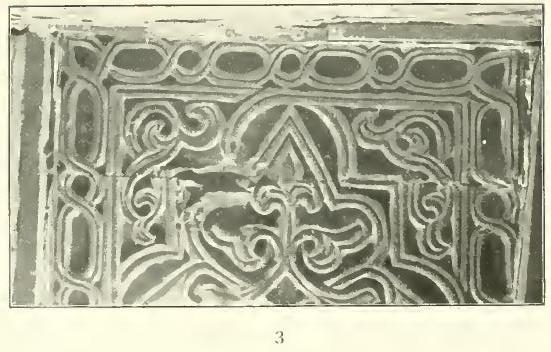 Figure 69. Ceiling, southeast at bottom (Flury, Ornamente, pl. 34, 3). |
The flat ceiling of the niched room is nearly square and is composed of two slabs, oddly not quite of equal width. A geometric band surrounds a square field bordered by a grooved band. Within the field is a grooved band forming a figure constructed as a square within the bordering square with semicircular lobes on the four sides. The interstices between this figure and the square border are filled with foliate flourishes. Within the figure is another figure formed by a grooved band that reciprocates inversely the forms of the outer figure: a near-square with semicircular projections, the semicircular projections within the corners of the square of the outer figure and the corners of the inner near-square within the semicircular projections of the outer figure. The inner figure is only near-square because the angles of its corners are acute rather than right angles. Within the inner figure is foliage organized in each half (so far as damage permits one to describe it) as two stems originating obscurely from the center, sprouting leaves, possibly involving themselves with the inner figure's grooved band, and joining to form a single stem that sprouts two double-lobed leaves and terminates in a trefoil palmette. This design seems very much like an exercise in space-filling.
The lobes of the outer figure are treated in three ways: on the southwest the lobe was almost certainly truncated by the border; on the northeast it overlaps it, and on the southeast and northwest one half of the lobe overcrosses the other (left over right in both cases), both running into the border.
Of the four foliate flourishes in the corners of the composition the two on the northeast have symmetry of reflection with respect to a northeast-southwest axis— note particularly the split leaves on the sides toward the center. The flourish in the west corner resembles these, with symmetry of reflection with respect to a northwest-southeast axis, but the split leaf toward the center is trilobed and faces the same way as the first two. In the flourish in the south corner the same leaf is curled back on itself.
[Link: Northeast side of niched room, Creswell Archive, negative EA.CA.3151 (Creswell, Muslim Architecture of Egypt, v. 1, pl. 31, d; see also fig. 42).]
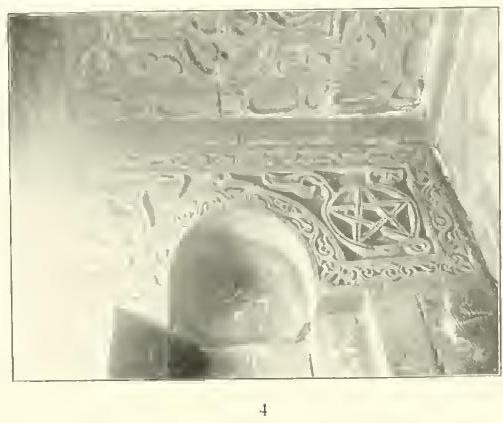 Figure 70. Northeast side of niched room; Flury, Ornamente, pl. 34, 4. |
I assume that the spandrels of the niches on both sides of the niched room are similar; Creswell illustrated only one (the same as appears in his drawing), and Flury published a photograph of what seems to be the same side, which is therefore the one I analyze here (while both are visible in Creswell Archive negative EA.CA.3147, they are shown at an extreme angle).
A foliate border projects from its background with a plain exterior border at the top and vertical sides. Inside the foliate border a thin flat band enframes the two spandrels; it is actually two loops, linking above the niche, a bit off-center. I know of no earlier example of spandrels treated in this manner. In each spandrel is a circle filled with a pentagram. The circles are elaborated to fill the remaining space with loops and foliage sprouting directly from them. There is no particular order or discipline to this elaboration, and it is somewhat different on the two sides. The pentagrams are constructed so that a single grooved band crosses alternately over and under itself to complete the figure. The crossings are different on the two sides, such that the two pentagrams have symmetry of reflection with respect to each other. The contrast in regularity and symmetry between the pentagrams and their surrounding elaborated circles suggests that the circled pentagrams were somehow significant (so received attention in detail) but that the loops and foliage were space-fillers only. Like the ceiling, they seem to have been executed almost freehand.
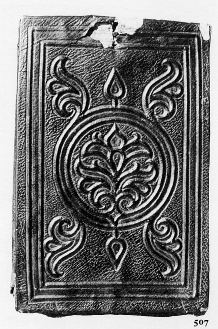 Figure 71. Part of a bookbinding, ninth–eleventh century. |
A fragment of a bookbinding found in the Great Mosque of Qayrawān, uncertainly dated to the ninth–eleventh centuries and said to be related technically to Coptic bookbindings, features a circle with palmettes growing from four points and an inner circle is attached to an internal palmette and two external pointed ovals, in all rather resembling this ornament; I wonder if it is not Cairene.121
As for the pentagrams, which I remarked on as possibly significant, I have no wish to engage in Fāṭimid iconology, but I list other occurrences of figures with five axes in aid of a larger point.122 Pentagrams, pentagons, and five-pointed stars appear in
the window frame of the window facing west of the seventh register of the cylindrical section of the northern minaret, where the five-pointed star disrupts the composition, a five-pointed star;
the openwork balustrade of the window facing north of the seventh register of the cylindrical section of the northern minaret, a five-pointed star standing on one point, formed of interlacing bands only parts of which belong to the figure;
in two medallions on the socle of the northern minaret, pentagons and a pentagram, see “The Medallions of the Socle of the Northern Minaret”;
and in a medallion in the eighth register of the cylindrical section of the northern minaret, a pentagram; see “The Medallions of the Eighth Register of the Northern Minaret”).
The larger point is that these forms may have been inserted at the insistence of the client. See Chapter Ten, The Carved Stone Ornament as a Whole for a fuller discussion.
107. The Bulletin of the Comité for 1907 (though that title does not appear on its first page) is on line at the Thesaurus Islamicus Foundation's Islamic Art Network, http://www.islamic-art.org/comitte/Comite.asp. The two photographs are pl. 2 and 3. Flury, op. cit., p. 49, n. 138, referred to this publication as Rapports du Comité de Conservation, fasc. 24, dating it in 1908. I believe that in this footnote he dates his pl. 19 (referred to as “meine erste Aufnahme”) to 1902, and it appears to have been taken at the same time as the Comité photographs.
108. Muslim Architecture of Egypt, v. 1, p. 70.
109. Creswell, ibid., pp. 88–89, described the salient part of the southeast side of the square section, but mentioned no squares; p. 96, n. 1, he wrote that the squares are not quite square; Flury, op. cit., p. 47, gave measurements.
110. Ibid., p. 96.
111. I thank Lorenz Korn for help in analyzing this design.
112. Op. cit., v. 1, p. 92. Flury gave the diameter of the inscribed medallion as 49 cm., op. cit., p. 44.
113. Op. cit., v. 1, p. 92.
114. On the inscription, which is Qurʿānic, see Bloom, “The Mosque of al-Ḥākim”, p. 35, and Bierman, op. cit., p. 82.
115. Op. cit., v. 1, p. 94.
116. Flury also mentioned squares with inserted semicircles (Vierecke mit eingesetzten Halbkreisen), which I have not visualized successfully, op. cit., p. 46.
117. Richard Goy, Florence, The City and its Architecture, London, 2002, p. 227 for dates and solar interpretation.
118. Op. cit., v. 1, pp. 98–99; for plan and elevations see fig. 41; for the room see pl. 31, b–d.
119. Ibid., p. 100.
120. Cairo, 2009.
121. Georges Marçais and Louis Poinssot, Objets Kairouanais, IXe au XIIIe siècle, 2 v., Tunis, 1948–52, v. 2, pp. 230–32, pl. 26; for a related example see pp. 236–38. Marçais and Poinssot did not illustrate all the bookbindings they described, but among those illustrated the main designs of these two are completely unrelated to the others, which are mostly interlaces and intertwinings, some quite sophisticated and not all of them closely related to interlaces and intertwinings in architectural ornament. Richard Ettinghausen mentioned this bookbinding but expressed no opinion as to its provenance (though he thought it could be earlier than the eleventh century) in “Foundation-moulded Leatherwork—a Rare Egyptian Technique also used in Britain”, Studies in Islamic Art and Architecture in Honour of Professor K.A.C. Creswell, pp. 63–71, pp. 69–70. Also published in Arts of Islam, no. 507, p. 319.
122. Creswell, p. 104 (referred to above) devoted a section to the topic, suggesting magical, talismanic, and, or, astrological significance, without citing any relevant evidence. However, the use of an interlacing pentagram filled with what is thought to be prophylactic pseudoscript on an Egyptian luster bowl dated to the early eleventh century indicates that the form had some significant association or associations (Barrucand, Trésors, p. 174).